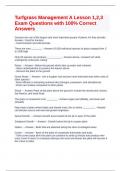Turfgrass Management A Lesson 1,2,3
Exam Questions with 100% Correct
Answers
Grasses are one of the largest and most important groups of plants, for they provide -
Answer-- Food for humans
- Feed livestock and wild animals
There are over ________ - Answer-10,000 individual species of grass ranging from 1"
to 100ft high
Only 50 species can produce ___________ - Answer-dense, compact turf while
undergoing continuous cutting
Roots - - Answer-- Below the ground which take up water and nutrients
- Store carbohydrates to produce the leaves above
- Secures the plant to the ground
Grass Roots - - Answer-- Are a tougher root and are more branched than other roots of
other specie's
- More efficient in extracting nutrients like (nitrogen, potassium, and phosphorus)
- Roots are shallow compared to other plants
Shoot - - Answer-Parts of the plant above the ground ( include the stem(culm), leaves,
tiny flowers, and seed head
The grass is composed of an ________ - Answer-upper part (Blade), and lower part
(Sheath)
Near base of plant where blade and sheath meet, this is where _________ - Answer-
cell division occurs and new leaf growth originates.
Apical Growth - - Answer-Growth area located at the tip or apex of the plant
Subapical Growth - - Answer-· Growth below the tip in a grass plant
Nodes - - Answer-· Buds that are attached along the stem at enlarged areas
Crown - - Answer-· Base of the plant of compacted internodes and buds.
· If the crown stays alive the plant can continue to send up shoots and produce new
roots. Even if insect or a disease destroys the roots and leaves the plant will recover if
the crown is intact
,Tillers - - Answer-· Shoots that grow in a tight, bunch-type pattern around the crown
· Each tiller develops into an independent plant. Some grasses, like perennial, ryegrass,
produce tillers only while others produce stems that grow sideways above or below
ground.
Stolons - - Answer-Above ground stems
Rhizomes - - Answer-Below ground stems
Plants manufacture the food they need to function through the process of
________________ - Answer-photosynthesis
Cells in grass, leaves contain __________ - Answer-chlorophyll, which is the molecule
that gives them their green color but more importantly, allows photosynthesis to occur
Chlorophyll - - Answer-collects light energy and uses it to produce carbohydrates
(sugars) from carbon dioxide and water, releasing oxygen in the process.
Plants use carbohydrates, as a source of _________________ - Answer-· energy for
powering functions such as nutrient absorption and reproduction, as well as for growth
of stems, & leaves
The carbohydrates produced by the plant are utilized through the process of
___________ - Answer-respiration
Respiration is the opposite of photosynthesis in that it uses __________ - Answer-
oxygen to convert the carbohydrates into energy, releasing carbon dioxide and water in
the process
Photosynthesis and respiration are influenced by several factors like ____________ -
Answer-- temperature
-amount of light
- water
Respiration can take place day or night while ______________ - Answer-
photosynthesis is only during the day
A plant needs - Answer-17 chemical elements which are divided into macronutrients
and micronutrients
Macronutrients can be further classified as ________ - Answer-primary or secondary
· 6 major macronutrients - Answer--Carbon
-Hydrogen
-Oxygen
-Nitrogen
, -Phosphorus
-Potassium
- 3 Major macronutrients which are sustained for growth, carbon, hydrogen, & oxygen
- Secondary macronutrients, sulfur, calcium, & magnesium
Golf course soil can be improved - Answer-either before or after turfgrass establishment
by amending it with sand, finely graded topsoil, compost or fertilizer
Existing soil called _________ - Answer-called native soil rarely meets the requirements
for maintaining healthy turfgrass
A soil composition and texture are the result of - Answer-- Sand
- Silt
- Clay
The texture of soil affects how well nutrients and water are retained in the soil -
Answer-- Sandy soil allows water & nutrients to penetrate easily, but pass through
quickly
- Clay soil holds nutrients and water better than sandy soils, but can be too dense and
retain to much water
- Compacted soil is a constant challenge on the course that experience heavy traffic
Loam - - Answer-is an ideal soil that provides just the right balance between drainage
and retention containing equal portions of sand, silt, clay and organic material
Thatch - - Answer-Tightly intermingled layer of dead and living stems, crowns, and roots
that develop between the growing turf plants and soil surface
Ph Rating - - Answer-measurements of the relative acidity and alkalinity of the soil.
- Scale from 0 to 14, where 7 is neutral meaning is neither acidic nor alkaline
Lower than 7 -
higher than 7 - - Answer-(soil is acidic)
(soil is alkalinity)
Turfgrass grows best in soil that is _______ - Answer-slightly acidic between 6.0 and
6.5
System developed by the USGA in 1960 and updated in 1993 - Answer-involves a top
layer of a mixture of sand and peat for the rootzone. This layer sits atop another layer of
pure sand, which in turn rests on a layer of gravel. Rather than draining out of the sand
layer, water and nutrients are retained in sufficient quantities, but excess water quickly




